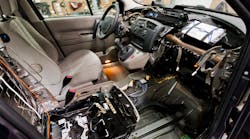Vehicles today are more complex than ever before, and the systems, parts and components contained inside them continue to change with time. This ongoing evolution requires fleet maintenance personnel to continually invest time, energy and resources into learning how to spot and address problems with vehicles to ensure they remain up, running and on the road.
There has been an increased prevalence in the use of electrical sensors, circuitry and control modules to operate systems in a vehicle that were once mechanical -- or didn’t even exist. As a result, it is critical for technicians to develop and continually maintain a sound understanding of what it will take to troubleshoot and address electrical sensors when they are not working properly.
“Technicians need to continuously attend training to improve their skills and keep current with the changing technologies,” says Thomas J. Bauman, director, sales, marketing and new product development, Hickok-Waekon (www.hickok-inc.com), a supplier of tools for service providers and technicians in the automotive and truck industries. “Multiplexed electrical systems and the use of high-speed communication protocols for vehicle control modules require specific tools and a good understanding of how the individual systems work.”
Constant Change
Vehicles are now incorporating increased safety controls such as autonomous braking and lane correction technology. These advancements have, overall, increased the difficulty with which technicians can troubleshoot electrical systems. Furthermore, drive-by-wire systems – like electronic steering and parking assist, where a vehicle can park itself without input from a driver – rely on communication that ultimately is raw, rapid electrical voltage.
“The complexity of the electrical systems in vehicles has skyrocketed,” says Matt Kenny, vice president, sales and marketing, Horizon Tool, a manufacturer and distributor of hand tool brands for the automotive aftermarket. Cal-Van Tools (www.cal-vantools.com) is the automotive specialty hand tool brand of Horizon Tool. “There are several modules communicating and analyzing many systems at any given time. In addition to complexity, there are just more electronics in vehicles.”
However, while the technological aspects of a vehicle are always changing, all electrical systems abide by the basic fundamentals of electricity magnetism and operate accordingly.
“The ease with which a technician can troubleshoot an electrical system is based upon his or her understanding of volts, amps, ohms, power, battery state of charge and the relationship of these items to each other,” says Charley Gipe, technical service representative, Purkeys (www.purkeys.net), a provider of electrical solutions to the heavy trucking industry. “A technician also must know diagnostic concepts, such as voltage drop, and be familiar with the use of foundational diagnostic tools such as DVOMs (digital volt ohm meters), ammeters, battery testers and more.”
Taking the time and putting in the effort to learn these concepts is crucial to being able to successfully address issues with electrical systems and minimize vehicle downtime, he says.
“I don’t mean memorize the definitions,” continues Gipe. “I mean learn them and how to apply them while diagnosing something. Learn the relationships between volts, amps and ohms (Ohm’s law), as well as the formula for power – volts times amps – and how to apply it when working to repair electrical systems.”
The Right Tools for the Task
Perhaps just as important, though, is effectively utilizing tools and equipment designed to troubleshoot electrical systems. Technological advancements have led to the development of innovative product offerings capable of making diagnoses of electrical systems faster and more accurate than what was once thought possible.
Once upon a time not so long ago, carbon piles were commonly used for battery and electrical system testing. While effective, they were manually operated and provided inaccurate results if used improperly.
Today, however, most testers are fully automatic. As a result, the setup process is significantly easier, and the test results gathered are both accurate and repeatable. For example, electrical analyzers designed to test battery, starting and charging systems – in addition to performing voltage drop testing on circuits – can be quite useful for electrical diagnosis.
“Since many of these tools are menu-driven, the technician uses a keypad to enter information into the tool – similar to a scan tool – and the tool guides him or her on what to do,” says Gipe of Purkeys. “Once the tester has the needed information, the test is run automatically.”
As with electrical analyzers, battery charging equipment is also quite easy to use and can consistently provide the results operators are looking for when employed.
“Many newer chargers offer automatic charging features, including flooded and AGM (absorbent glass mat) battery technology, which make charging safe, fast and effective,” Gipe says. “Even simple features, such as min/max settings on DVOMs, are common, and they can be very useful if you know how to use them.”
According to Hickok-Waekon’s Bauman, oscilloscopes have become a “must-have” tool for technicians to view waveforms of the complex electrical systems over and above what a typical scan tool can provide.
“Viewing the raw voltages can reveal disruptions in communications, causing problems scan tools cannot see,” he adds.
Obstacles to Overcome
While the products designed to help maintenance personnel troubleshoot, diagnose and repair electrical systems have continued to develop and improve with time, a couple of factors make it difficult for today’s technicians to be able to use them efficiently and effectively. One of great significance, says Purkeys’ Gipe, is a lack of electrical fundamentals and how to apply them when performing diagnostics.
“This understanding has to be second nature, as does how to use foundational electrical diagnostic equipment, such as DVOMs and ammeters, to accumulate the data needed to diagnose an electrical problem,” he says.
A second factor of significance, Gipe adds, is the lack of information available to technicians on new electrical features and their core functions, as they arrive to market with limited access to information on how to operate them correctly and apply them appropriately. However, he notes that these issues can be overcome by regularly using tools at one’s disposal for practice and training.
“If the DVOM you have is two years old, but still is in the original packaging, get it out and start practicing with it,” Gipe says. “A tool you never get out is of little use. Do you have a clip-on ammeter? If you don’t, why not? How do you measure current flow in a circuit without one?”
Horizon Tool’s Kenny agrees that proper tools and training are critical to ensuring maintenance personnel are equipped to properly address issues with electrical systems in vehicles.
“No longer can a technician jab a $5 test light in a circuit and expect to troubleshoot a problem,” he says. “Unlike mechanical systems that are tangible, all electronic systems require special tools to hunt down malfunctions. No technician can understand every system on a vehicle, so they must have tools that are capable of pointing them in the right direction.”
Looking Ahead
Electrical systems – along with other systems, parts and components of a vehicle – will continue to evolve with time, and maintenance personnel will need to prepare to meet the ever-changing challenges associated with repairing them. Higher voltage systems are expected to become commonplace as the demands on electrical systems increase.
Furthermore, the rise of autonomous driving technology means vehicles will become even more complex, and are expected to require an increased amount of high-speed electrical communication.
According to Horizon Tool’s Kenny, as with any type of computer, vehicle electronics will do more, faster – and in less space. In addition, he says, the increased prevalence of automated vehicles on the road will lead to continuous, large amounts of data being analyzed in fractions of a second.
“The Internet of Things will enable huge volumes of data to be transmitted and consumed at a record pace,” he continues, noting that not only will technicians be required to understand the systems to avoid costly and unwanted vehicle downtime, but also to ensure the safety of the fleets they service.
“What is certain is a that good understanding of electrical fundamentals and how to use basic electrical diagnostic equipment will always be needed, regardless of how electrical systems evolve,” adds Gipe of Purkeys.




